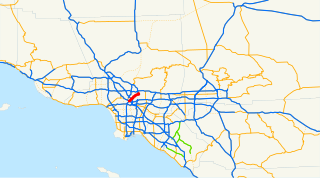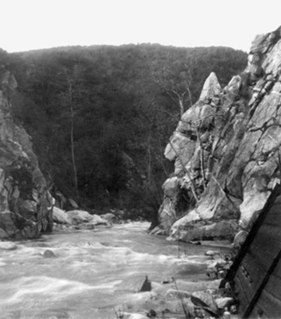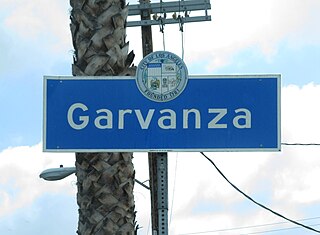Related Research Articles

Pasadena is a city in Los Angeles County, California, 11 miles (18 km) northeast of downtown Los Angeles. It is the most populous city and the primary cultural center of the San Gabriel Valley. Observers consider it as either a suburb of nearby Los Angeles or, with its substantial downtown area, as a significant urban center in its own right.

The Arroyo Seco Parkway, also known as the Pasadena Freeway, is one of the oldest freeways built in the United States. It connects Los Angeles with Pasadena alongside the Arroyo Seco seasonal river. It is notable not only for being an early freeway, mostly opened in 1940, but for representing the transitional phase between early parkways and modern freeways. It conformed to modern standards when it was built, but is now regarded as a narrow, outdated roadway. A 1953 extension brought the south end to the Four Level Interchange in downtown Los Angeles and a connection with the rest of the freeway system.
Route 110, consisting of State Route 110 (SR 110) and Interstate 110 (I-110), is a state and auxiliary Interstate Highway in the Los Angeles metropolitan area of the US state of California. The entire route connects San Pedro and the Port of Los Angeles with Downtown Los Angeles and Pasadena. The southern segment from San Pedro to I-10 in downtown Los Angeles is signed as I-110, while the northern segment to Pasadena is signed as SR 110. The entire length of I-110, as well as SR 110 south of the Four Level Interchange with US Route 101 (US 101), is the Harbor Freeway, and SR 110 north from US 101 to Pasadena is the historic Arroyo Seco Parkway, the first freeway in the western United States.

Highland Park is a neighborhood in northeast Los Angeles, California. It was one of the first subdivisions of Los Angeles and is inhabited by a variety of ethnic and socioeconomic groups.

The Arroyo Seco, meaning "dry stream" in Spanish, is a 24.9-mile-long (40.1 km) seasonal river, canyon, watershed, and cultural area in Los Angeles County, California. The area was explored by Gaspar de Portolà who named the stream Arroyo Seco as this canyon had the least water of any he had seen. During this exploration he met the Chief Hahamog-na (Hahamonga) of the Tongva Indians.

Marion Kavanaugh Wachtel was an American plein air painter in watercolors and oils. She lived and worked with her artist husband Elmer Wachtel in the Arroyo Seco near Pasadena, California, in the early 20th century.

The Arroyo Seco Bicycle Path is an approximately 2 miles (3.2 km) long Class I bicycle path along the Arroyo Seco river channel in the Northeast Los Angeles region of Los Angeles County, California. It parallels to the Arroyo Seco Parkway also in the canyon.
The Hahamog'na, commonly anglicized to Hahamongna and spelled Xaxaamonga in their native language, are a tribe of the Tongva people of California. Their language belongs to the Uto-Aztecan family.

Franz Albert Bischoff was an American artist known primarily for his China painting, floral paintings and California landscapes. He was born in Steinschönau, Austria. He immigrated to the United States as a teenager where he became a naturalized citizen. While in Europe, his early training was focused upon applied design, watercolor and ceramic decorations.
Southland Publishing, Inc. is a publishing company based in Pasadena, California with five offices in Southern California. The company produces weekly newspapers, monthly magazines, direct mail products, and affiliated websites throughout California and selected states throughout the U.S.

Southwest Museum is an at-grade light rail station on the L Line of the Los Angeles Metro Rail system. It is located near the intersection of Marmion Way at Museum Drive in the Mount Washington neighborhood of Los Angeles. The station opened on July 26, 2003, as part of the original Gold Line, then known as the "Pasadena Metro Blue Line" project.

Garvanza is a neighborhood in northeast Los Angeles bordered by Highland Park to the west, South Pasadena to the east, and Pasadena to the north. Seven Los Angeles Historic-Cultural Monuments are located in the neighborhood.

Judson Studios is a fine arts studio specializing in stained glass located in the Highland Park section of northeast Los Angeles. The stained glass studio was founded in the Mott Alley section of downtown Los Angeles in the mid-1890s by English-born artist William Lees Judson and his three sons. It moved to its current location in 1920 and remains in operation as a family-run business. The Judson Studios building was named a Historic-Cultural Landmark by the City of Los Angeles in 1969 and listed in the National Register of Historic Places in 1999.

Lummis House, also known as El Alisal, is a Rustic American Craftsman stone house built by Charles Fletcher Lummis in the late 19th and early 20th centuries. Located on the edge of Arroyo Seco in northeast Los Angeles, California, the house's name means "alder grove" in Spanish.
Lummis Day is a signature community arts and music event in the neighborhoods of Northeast Los Angeles, showcasing the community's considerable pool of musicians, poets, artists, dancers and restaurants representing a kaleidoscope of ethnicities and cultural traditions. Since 2014, Occidental College's Institute for the Study of Los Angeles has partnered with the Lummis Day Community Foundation to support cultural programming.

The terms California Impressionism and California Plein-Air Painting describe the large movement of 20th century California artists who worked out of doors, directly from nature in California, United States. Their work became popular in the San Francisco Bay Area and Southern California in the first three decades after the turn of the 20th century. Considered to be a regional variation on American Impressionism, the painters of the California Plein-Air School are also described as California Impressionists; the terms are used interchangeably.
Harry "Ward" Ritchie was an American printer, book designer, book-collector and writer of around 100 books. He was part of the "Golden Age" of fine printing that took place during the 1920s and 1930s in Southern California. Ritchie was also part of the Artists of the Arroyo Seco community.

Idah Meacham Strobridge was an American writer and bookbinder. Known primarily for a trio of works about the Great Basin which mix folktales, fiction, sketches, and nature writing: In Miners' Mirage-Land (1904), The Loom of the Desert (1907) and The Land of Purple Shadows (1909).

Elmer Wachtel (1864-1929) was an American painter who lived and worked in Southern California. He was known for his impressionist landscapes.
Alice Parsons Millard was an American bookseller and promoter of culture in the Arroyo Seco region of Los Angeles County. She is widely known for commissioning Frank Lloyd Wright to build her house in Pasadena.
References
- 1 2 Starr, Kevin (1985). Inventing the Dream, California in the Progressive Era . New York: Oxford University Press. pp. 380. ISBN 0-19-503489-9.
- ↑ Ritchie, Ward (1996). A Southland Bohemia, The Arroyo Seco Colony as the Century Begins. Pasadena: Vance Gerry. p. 25.
- ↑ Alden Lee Hill (1937-03-20). "The Highlands of Los Angeles: William Lees Judson" (PDF). Highlands Radio Program.